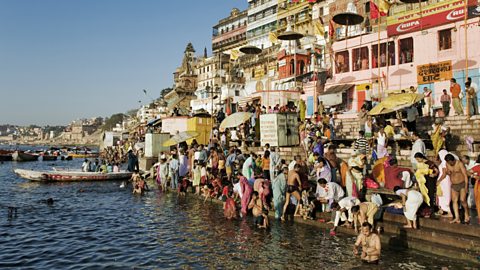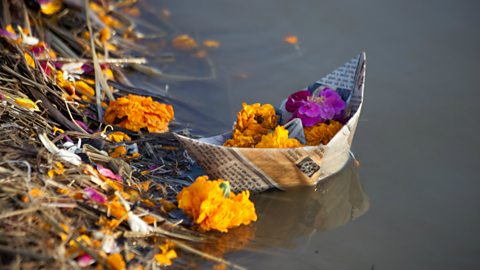Pilgrimage
A pilgrimageA journey which has religious or spiritual significance, usually to an important religious place. is a special religious journey that is made for a specific purpose. Hindus believe that pilgrimage is important and should be carried out if possible. Hindus have many different important and sacred places in their religion, and these are usually linked to different deity / deitiesOne god or goddess. In Hinduism, the word for gods and goddesses that many Hindus believe are different aspects of the one Supreme Spirit (Brahman).. A pilgrimage can help Hindus by connecting them with BrahmanIn Hindu belief, the absolute reality that is the true essence of all existence, God.. Through pilgrimage, they can show their belief in God and gain a better understanding of an important holy site. It is also a way of meeting other Hindus who share their beliefs and trying to work towards achieving mokshaUltimate goal for all atman (spirits/souls) as laid out in Hindu scripture; escape from the cycle of reincarnation..
Varanasi

The most sacred city in Hinduism is VaranasiVaranasi is one the oldest and holiest cities in Hinduism. It is an important pilgrimage place as it is where Shiva is believed to have lived., as it is one of the oldest and most respected cities. It is believed to be the city where Shiva (Hinduism)A Hindu deity. The aspect of Brahman responsible for destruction and renewed creation. Some Hindus regard Shiva as the one Supreme Deity., the god of destruction, lived a long time ago. The river GangesThe most holy river for most Hindus., which is one of the most sacred rivers in the world, runs through the city and is important as it is where Hindus bathe in the hope they can wash their sins away. A lot of Hindus believe that people who die in the city of Varanasi can achieve moksha.
Kumbh Mela
One of the most important pilgrimages in Hinduism is Kumbh Mela. This is the largest gathering of people in the world. Millions of people attend and bathe in the Ganges (in North India). The main Kumbh Mela gathering takes place every 12 years, with other events taking place every three years at four different sites (a different site is used every three years).
It started because of the story of the Garuda, which was a bird. The bird picked up a jar that contained immortality nectar, but four drops of the nectar fell into the Ganges. Hindus therefore bathe in the Ganges with the hope of having their sin washed away and their soul purified.
The Kumbh Mela pilgrimage lasts for 55 days and hosts many different types of Hindus, who tell stories and entertain other people. Many Hindus wear flower garlands around their neck and then throw them into the Ganges as an offering. Hindu holy men attend the pilgrimage and lead processions into the Ganges.
Hindus hope that this pilgrimage will make them blessed by God and help them achieve their ultimate goal of moksha through their devotion.
